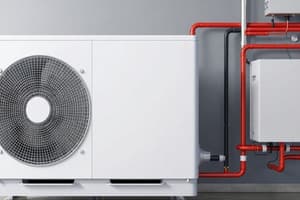Podcast
Questions and Answers
Which of the following best describes the role of the compressor in a heat pump system?
Which of the following best describes the role of the compressor in a heat pump system?
- It reduces the pressure of the refrigerant to prepare it for evaporation.
- It absorbs heat from the external environment, cooling the refrigerant.
- It increases the pressure and temperature of the refrigerant, enabling heat transfer. (correct)
- It facilitates the condensation of the refrigerant from vapor to liquid.
In a heat pump system, what is the primary function of the expansion valve?
In a heat pump system, what is the primary function of the expansion valve?
- To increase the pressure of the refrigerant before it enters the compressor.
- To reduce the pressure of the refrigerant, causing partial vaporization. (correct)
- To absorb heat from the surroundings, cooling the refrigerant.
- To condense the high-pressure refrigerant into a liquid state.
When a heat pump uses groundwater as its cold source, what type of energy is being utilized?
When a heat pump uses groundwater as its cold source, what type of energy is being utilized?
- Geothermal energy
- Hydrothermal energy
- Aquathermal energy (correct)
- Aerothermal energy
What thermodynamic principle allows the evaporator to absorb heat from the external environment (air, water, or soil)?
What thermodynamic principle allows the evaporator to absorb heat from the external environment (air, water, or soil)?
Which component of a heat pump is responsible for releasing heat into the hot source, such as the air or water inside a building?
Which component of a heat pump is responsible for releasing heat into the hot source, such as the air or water inside a building?
A heat pump is used to heat a building using a geothermal source. Which of the following describes the energy transfer process?
A heat pump is used to heat a building using a geothermal source. Which of the following describes the energy transfer process?
What is the state of the fluid as it LEAVES the condenser in a heat pump system?
What is the state of the fluid as it LEAVES the condenser in a heat pump system?
Which of the following is NOT a key component of a standard heat pump system?
Which of the following is NOT a key component of a standard heat pump system?
If a heat pump is drawing heat from the outside air to heat a building, and the outside temperature drops significantly, what would be the expected impact on the heat pump's performance?
If a heat pump is drawing heat from the outside air to heat a building, and the outside temperature drops significantly, what would be the expected impact on the heat pump's performance?
Which statement accurately describes the role of a heat exchanger in a heat pump's condenser and evaporator?
Which statement accurately describes the role of a heat exchanger in a heat pump's condenser and evaporator?
Flashcards
What is a heat pump?
What is a heat pump?
A device that transfers heat energy from a cold source to a hot source.
What is a cold source?
What is a cold source?
The medium from which energy is extracted by a heat pump.
What is aerothermal energy?
What is aerothermal energy?
Air as a cold source for a heat pump.
What is aquathermal energy?
What is aquathermal energy?
Signup and view all the flashcards
What is geothermal energy?
What is geothermal energy?
Signup and view all the flashcards
What is a compressor?
What is a compressor?
Signup and view all the flashcards
What is a condenser?
What is a condenser?
Signup and view all the flashcards
What is an expansion valve?
What is an expansion valve?
Signup and view all the flashcards
What is an evaporator?
What is an evaporator?
Signup and view all the flashcards
Study Notes
Overview of Heat Pumps
- A heat pump transfers heat energy from a cold source to a hot source.
Cold and Hot Sources
- A cold source is the medium from which energy is extracted.
- Aerothermal energy uses air as the cold source.
- Aquathermal energy uses water (e.g., groundwater, lake, or river) as the cold source.
- Geothermal energy uses the ground as the cold source.
- Hot sources are where the energy is released.
- Energy is often released directly into the air through wall units, fan coil units, or ceiling panels.
- Energy can be released into water through a coil in the floor (underfloor heating) or into low or high-temperature radiators.
Thermodynamic Principles
- Heat pumps operate based on fluid evaporation and condensation.
- Fluid evaporation results in energy absorption.
- Fluid condensation results in energy release.
Components of a Heat Pump
- Key components of a heat pump include:
- Compressor
- Condenser
- Expansion valve (detenteur)
- Evaporator
Functioning of Each Component
- Compressor:
- Aspirates low-pressure, low-temperature gas from the evaporator.
- Mechanical energy increases pressure and temperature.
- Compressing air generates heat.
- Divides the circuit into high-pressure and low-pressure sides.
- Creates a pressure difference to circulate the fluid.
- Condenser:
- Heat exchanger facilitating condensation (vapor to liquid).
- Fluid enters as vapor and exits as liquid.
- Heat from compression is higher than the temperature of the hot source (air or water).
- Allows energy transfer.
- Expansion Valve:
- Reduces pressure to partially vaporize the fluid.
- Fluid enters as liquid and passes through a small calibrated opening.
- Partial vaporization prepares the fluid for evaporation.
- Evaporator:
- Functions as a heat exchanger.
- Fluid enters mainly as liquid from the expansion valve.
- Absorbs heat from the external fluid (air, water, or soil).
- Heat from the external fluid is higher than the evaporation temperature.
- The temperature differential facilitates energy transfer.
Studying That Suits You
Use AI to generate personalized quizzes and flashcards to suit your learning preferences.




